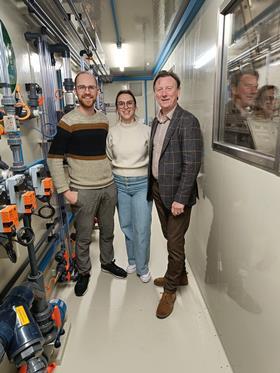Elutriators are used to prevent ammonia from entering the atmosphere. A new system using a plasma reactor makes the nitrogen cycle in pig houses circular.
Livestock farming is responsible for a large proportion of ammonia emissions in the Netherlands, Flanders and beyond. Farmers have to take measures to reduce emissions, for example by installing elutriators in stables. There are roughly two types: chemical scrubbers and biological scrubbers. Chemical scrubbers capture ammonia by passing stable air through a filter. Here it is washed with an aqueous solution of sulphuric acid, producing the salt ammonium sulphate. Biological elutriators use micro-organisms to convert ammonia into nitrate and nitrite. Both systems have the disadvantage of using chemicals and a lot of water, and produce a lot of waste water.
At KU Leuven’s TRANSfarm research facility, the research team of Johan Martens, Professor of Surface Chemistry and Catalysis at the Faculty of Bioengineering, has installed an innovative elutriator. Thanks to the use of a plasma reactor, no chemicals are needed as raw materials and water consumption is ten times lower than for traditional elutriators. The system also produces ammonium nitrate, which can be used as fertiliser.
Air and water
Martens’ group’s approach to the ammonia problem is completely different from the approach of current elutriators. The new installation uses only air and water as raw materials. And in an unusual way, he explains: ‘We use a plasma reactor to convert ambient air into nitrogen and NOx. Under these conditions, a high concentration of NOx is produced.’ This reacts with water to form nitric acid, and in a final step the nitric acid reacts with ammonia to form ammonium nitrate.

700 pigs
This application of plasma is based on developments by the PLASMANT research group at the University of Antwerp, led by Annemie Bogaerts. Martens’ group works closely with them.
In two years, the researchers scaled up the conversions, first from laboratory scale to a pilot plant of fifty litres and then to a demonstration model of five thousand litres, says Martens. The installation now treats the stable air from the seven hundred piglets housed at TRANSfarm. ‘The elutriator is capable of treating thousands of litres of air.’
Martens points out that the plasma reactor is powered by solar energy. ‘You can therefore adapt the installation to the availability of green energy. If there is a lot of solar energy available during the day, you can run the plasma reactor to produce nitric acid. You can then store it temporarily.’ In this way, excess green power is stored as a chemical, and this system can also act as a buffer to stabilise the electricity grid. ‘On days when the sun is not shining as much, you can still use the nitric acid to remove ammonia from the air in the barn without using extra energy.’
Fertiliser
Producing ammonium nitrate has a big advantage over ammonium sulphate, which is produced in conventional air washers, says Martens. ‘Ammonium nitrate is an interesting fertiliser. It contains nitrogen in the form of both ammonia and nitrate. Both forms are useful for plant growth. Ammonium sulphate only has nitrogen in the form of captured ammonia, and plants do not need as much sulphur. By converting ammonia from stable air into a fertiliser, we are creating a circular nitrogen economy.’
Another advantage is that ammonium nitrate is more soluble in water. ‘Ammonium sulphate forms crystals even at low concentrations’, Martens explains. ‘That means you need a lot more effluent to dispose of it. Our effluent is 50 per cent ammonium nitrate.’ Overall, the new installation uses up to ten times less water than the current elutriators, according to Martens. ‘With this reactor we can recirculate the water, whereas in normal elutriators a lot of water evaporates.’
Spin-off
Martens’ group plans to commercialise the technology through a spin-off company. Next year, the researchers will test the installations on farms. ‘We will collect field data on performance, water and energy consumption.’ The next step is to tackle the ‘odour problem’ of livestock housing. The typical stable odour is usually caused by certain acids and volatile organic compounds. ‘We are now working on an additional module that can also remove odours from the air’, concludes Martens.













Nog geen opmerkingen